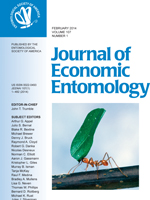Outdoor residual sprays are among the most common methods for targeting pestiferous ants in urban pest management programs. If impervious surfaces such as concrete are treated with these insecticides, the active ingredients can be washed from the surface by rain or irrigation. As a result, residual sprays with fipronil and pyrethroids are found in urban waterways and aquatic sediments. Given the amount of insecticides applied to urban settings for ant control and their possible impact on urban waterways, the development of alternative strategies is critical to decrease the overall amounts of insecticides applied, while still achieving effective control of target ant species. Herein we report a “pheromone-assisted technique” as an economically viable approach to maximize the efficacy of conventional sprays targeting the Argentine ant. By applying insecticide sprays supplemented with an attractive pheromone compound, (Z)-9-hexadecenal, Argentine ants were diverted from nearby trails and nest entrances and subsequently exposed to insecticide residues. Laboratory experiments with fipronil and bifenthrin sprays indicated that the overall kill of the insecticides on Argentine ant colonies was significantly improved (57–142% increase) by incorporating (Z)-9-hexadecenal in the insecticide sprays. This technique, once it is successfully implemented in practical pest management programs, has the potential of providing maximum control efficacy with reduced amount of insecticides applied in the environment.
How to translate text using browser tools
1 February 2014
Pheromone-Assisted Techniques to Improve the Efficacy of Insecticide Sprays Against Linepithema humile (Hymenoptera: Formicidae)
Dong-Hwan Choe,
Kasumi Tsai,
Carlos M. Lopez,
Kathleen Campbell
ACCESS THE FULL ARTICLE
It is not available for individual sale.
This article is only available to subscribers.
It is not available for individual sale.
It is not available for individual sale.
(Z)-9-hexadecenal
bifenthrin
fipronil
integrated pest management
runoff





